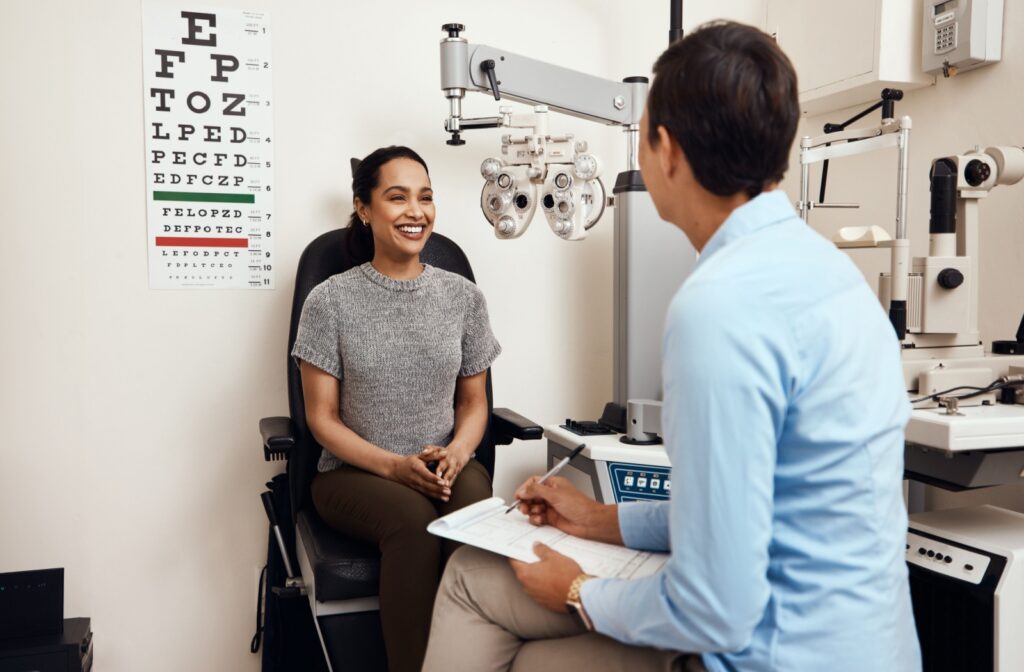Maintaining good eye health is essential for living a full and active life. Our eyes are responsible for a lot, from appreciating the beauty of a sunset to completing work tasks on a computer to connecting with loved ones. Naturally, their care deserves our attention. One common issue affecting many people’s eye health is dry eye disease.
A dry eye exam is a comprehensive evaluation performed by an eye care professional to determine the presence and severity of dry eye and create a tailored plan for relief. These exams go beyond a standard eye test to address discomfort, diagnose the root problem, and provide solutions to help you see and feel better.
What Is Dry Eye?
Dry eye occurs when your eyes either do not produce enough tears or the tears are too low-quality to maintain a stable tear film. This can lead to symptoms such as:
- Irritation
- Redness
- Sensitivity to light
- Blurred vision
- A burning or gritty sensation
- Stringy mucus
Surprisingly, even if your eyes are particularly watery, you could still have dry eye! In some cases, the eye produces tears to counter irritation and dryness, but these tears are often low-quality and don’t provide any real relief.
Left untreated, dry eye syndrome can interfere with daily activities like reading, driving, or prolonged screen use.
The role of a dry eye exam is to detect this condition early, assess its severity, and develop a treatment plan tailored to your needs.
Who Needs a Dry Eye Exam?
Anyone can develop dry eye, but some are at a higher risk and more likely to experience it. If you know your risks, you can better understand when a dry eye exam might be beneficial.
- Prolonged screen time: Long hours spent in front of computers or other digital screens can lead to less blinking, which decreases tear spread.
- Older adults: Tear production tends to decline with age, making people over 50 more susceptible to dry eye.
- Medical and biological factors: Conditions like diabetes, autoimmune diseases, or hormonal changes (common in menopause) increase dry eye risks.
- Contact lens wearers: Consistent contact lens use can disrupt tear film balance and contribute to symptoms.
- Certain environments: Prolonged exposure to dry, windy, or air-conditioned environments can lead to dry eye issues.
- Lifestyle factors: Smoking, poor diet, inadequate sleep, and chronic stress can all impact tear production and worsen dry eye symptoms.
If you deal with any of these factors and experience persistent eye discomfort, it may be time to book a dry eye exam.

Preparing for a Dry Eye Exam
Preparing for an eye exam can help you get the most out of your experience. Here are some things to keep in mind that can help your optometrist get a more accurate diagnosis:
- Record your symptoms: Note when discomfort occurs, how often it happens, and what activities may aggravate or ease your symptoms.
- List your medications: Include both systemic medications (like antihistamines) and any topical treatments you use, as they could contribute to dry eye.
- Document your eye care habits: Mention any contact lens use, eye drops, or previous treatments you’ve tried.
Your optometrist will appreciate and use this information to provide more precise care.
What Happens During a Dry Eye Exam
A dry eye exam is very similar to a routine comprehensive eye exam with a few additional tests to focus specifically on dry eye. Here is a quick overview of the process so you know what to expect:
- Tear film evaluation: Your optometrist will assess the quality and stability of your tear film using specialized tools to identify any deficiencies.
- Tear production tests: Tests like Schirmer’s measure how much moisture your eyes produce using small strips of paper.
- Eye surface staining: Noninvasive dyes highlight damage or dryness on the ocular surface, aiding in diagnosis.
Most dry eye exams are relatively quick, lasting around 30–60 minutes. It’s a straightforward process designed to leave you on the path to better eye comfort.
How Do Optometrists Treat Dry Eye?
Taking the time for a dry eye exam affects your immediate comfort and long-term eye health. A wide range of options are available for managing dry eye, and your optometrist will guide you to the solutions most suited to you. Some treatments include:
- Artificial tears: Over-the-counter or prescription eye drops can provide immediate relief by supplementing tear production.
- Bruder masks: These heated masks help unclog oil glands in the eyelids, improving tear quality.
- Omega-3 supplements: While research is ongoing, some studies suggest that dietary omega-3 fatty acids can improve tear function and reduce inflammation for those deficient in this nutrient.
With these strategies, dry eye can become much more manageable in daily life.
Clearer Vision Means Happier Eyes
Don’t wait for symptoms to worsen—addressing dry eye now can lead to more comfortable days ahead. At Northern Lights Eyecare, we’re committed to providing personalized care to help you achieve just that.
Book your dry eye exam with our team today and experience the difference comfortable vision can make!


